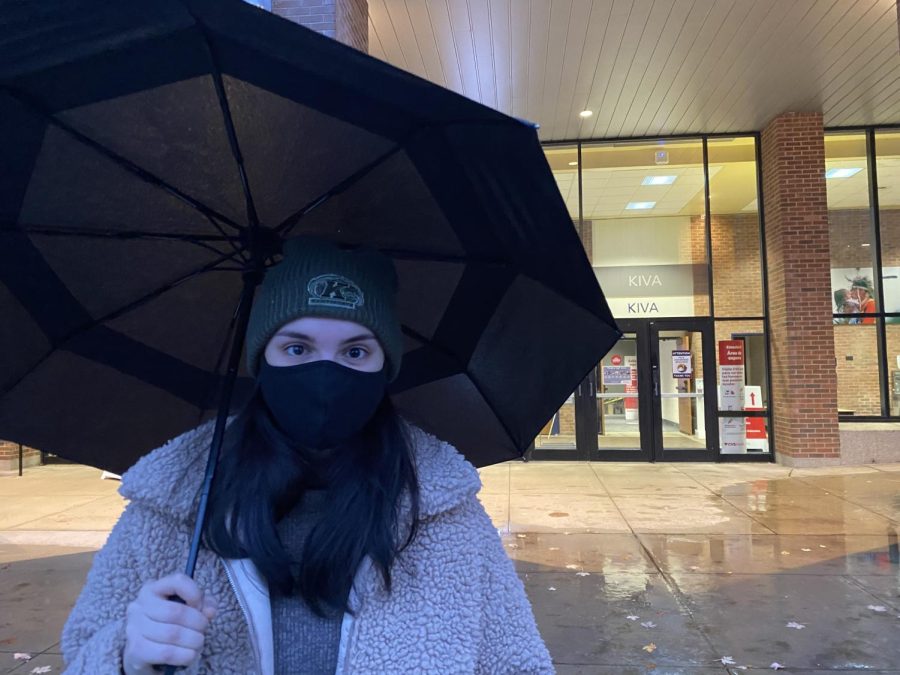What it’s like getting tested for COVID-19
November 2, 2020
Athena Zerefos arrived at the KIVA auditorium before sunrise on a cold and rainy day. Equipped with her boots, umbrella and mask, she was prepared to wait outside for the results of her COVID-19 test. Being randomly selected the week before, she knew what to expect.
Kent State randomly selects 450 individuals a week to participate in free testing conducted by CVS. Those selected have a significant presence on campus, such as students living in residence halls and those taking in-person classes. Students selected have a five-day window to get tested.
As of now, students living on campus do not have to get tested per the fall 2020 housing contract, so those who are chosen for random testing are not required to do so. However, students who want to remain on campus next semester must submit an updated spring 2021 housing contract that requires them to get randomly tested.
For her second time getting tested, Zerefos chose the earliest possible time to avoid a line. She arrived before the team was ready, so she waited in front of the stage of medical professionals who were wearing full-body personal protective gear behind plexiglass barriers.
Once the team was ready for her, she walked on stage to verify her identity and answer a few questions. Zerefos had to repeat herself to be heard from behind her mask. The only “yes” she gave was to the question, “Have you been in a high-risk setting for COVID?” As a biology pre-med student, she volunteers at the University Hospitals Portage Medical Center once a week.
Then, Zerefos conducted her self-swab. She was told to move the swab around in both nostrils for 15 seconds as if she was stirring soup. She said the test makes you feel like you have to sneeze since “you’re digging around up in your nose, but it doesn’t hurt.”
The samples are tested using the Abbott ID NOW COVID-19 test, a type of rapid test.
“I feel like whenever there’s something like that where you’re getting chosen out of so many students, it feels like it could never be you,” Zerefos said. “I’m glad I got chosen because I probably wouldn’t have come and gotten tested on my own.”
Both times she was tested, Zerefos received the call with her negative test result within 20 minutes. She appreciates the quick results, but she questions the effectiveness of the rapid test.
“I wish they had the more accurate test that gets sent into a lab because I can’t help but feel like these just aren’t that accurate,” Zerefos said. “I would almost rather have a more painful test that takes longer to get the results back, but that’s more accurate than a quick test.”
According to the CVS COVID-19 fact sheet provided by the testing site, “A negative test result does not completely rule out being infected with COVID-19. If you test negative for COVID-19, this means the virus was not detected at the time your specimen was collected.”
Likewise, according to a press release from the FDA, “The FDA has received 15 adverse event reports about the Abbott ID NOW device that suggest some users are receiving inaccurate negative results.”
However, Zerefos still sees worth in receiving the ID NOW test.
“I kind of want to keep getting tested every week, because what if I get tested today, and the results are negative, but I’m really positive. Then I get tested again next week and they catch it,” Zerefos said. “Especially since I’m going to the hospital and I’m going home to my parents. I’m really careful, but it is a high-risk environment.”
Although it is not currently mandatory to get tested, Zerefos believes students should still comply.
“We should all be doing our part to keep each other safe. It’s literally that simple. I’m trying to keep my family safe and I’m trying to keep the people in my classes safe and the people at the hospital safe,” Zerefos said. “It’s not even a painful test so I don’t understand why you would not want to get it done. It just seems selfish.”
Megan Becker covers COVID-19. Contact her at [email protected].
SUPPORT STUDENT MEDIA
Hi, I’m Lauren Sasala, a senior journalism student from Toledo. I’m also the editor in chief of The Kent Stater and KentWired this semester. My staff and I are committed to bringing you the most important news about Kent State and the Kent community. We are full-time students and hard-working journalists. While we get support from the student media fee and earned revenue such as advertising, both of those continue to decline. Your generous gift of any amount will help enhance our student experience as we grow into working professionals. Please go here to donate.












